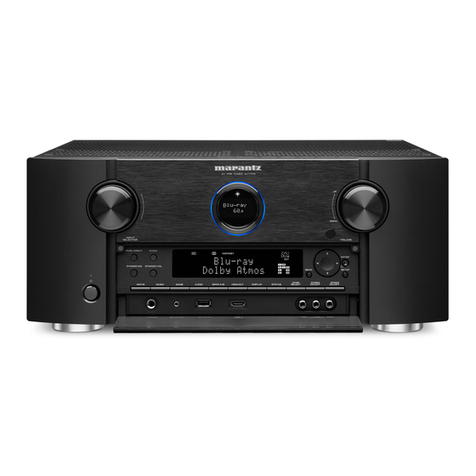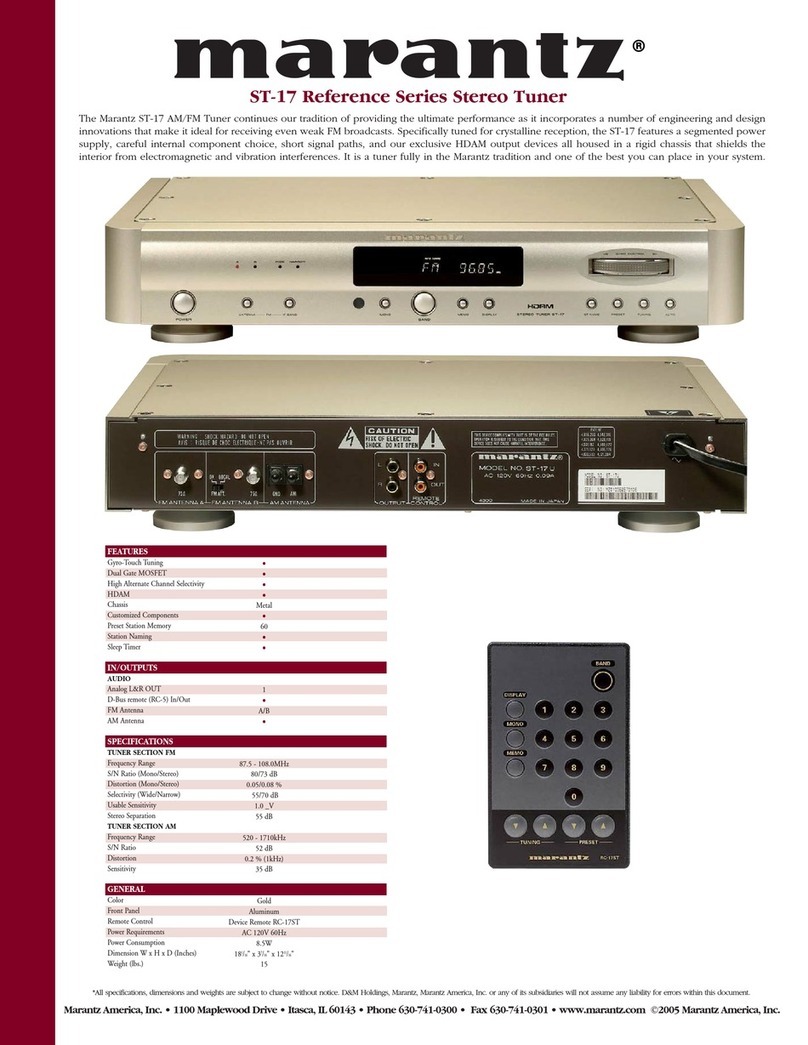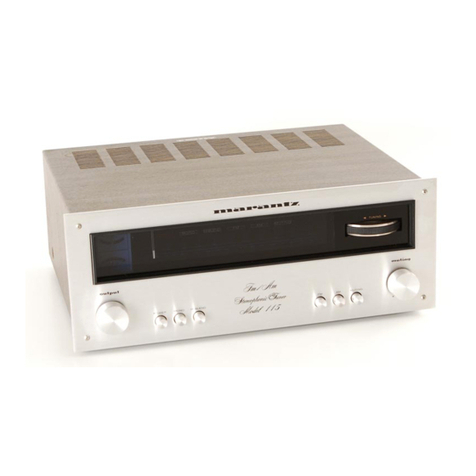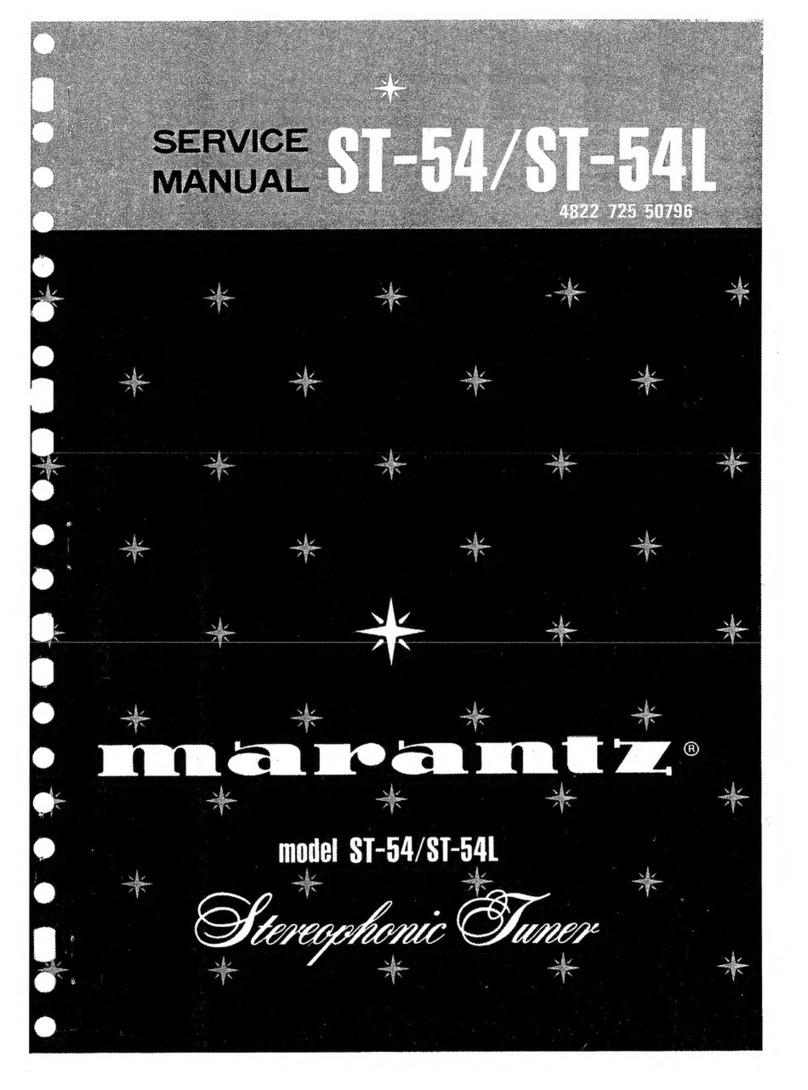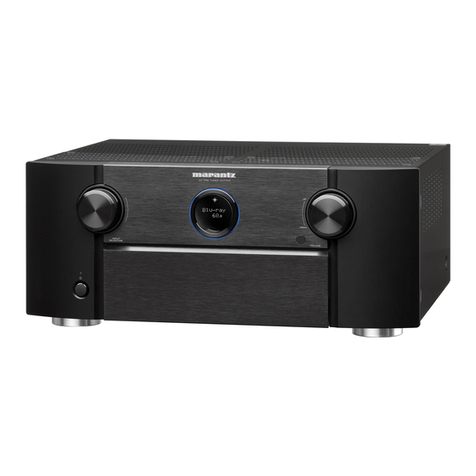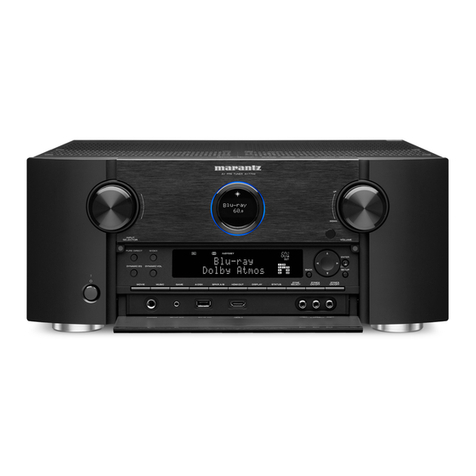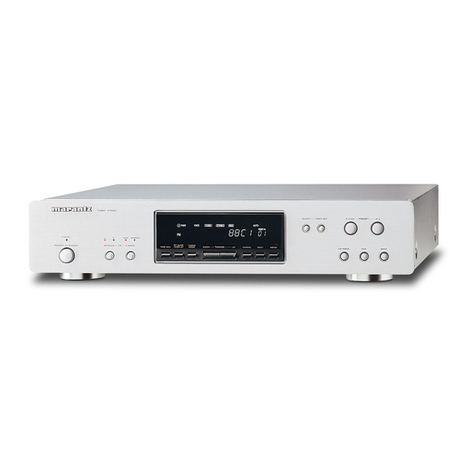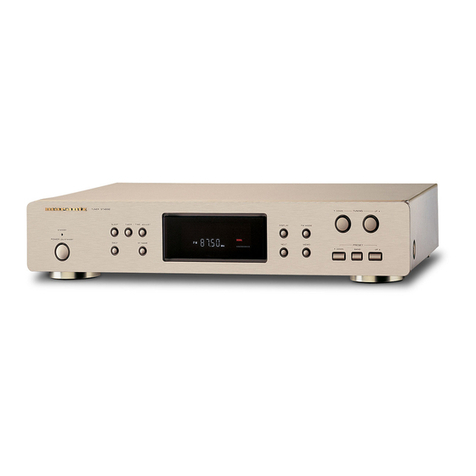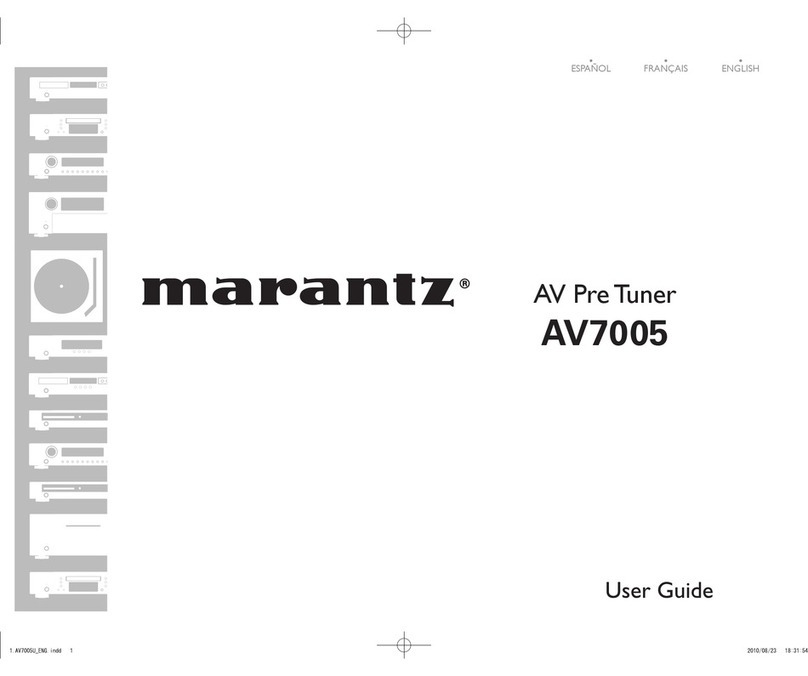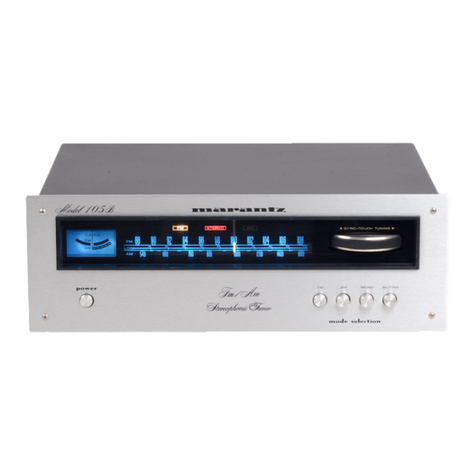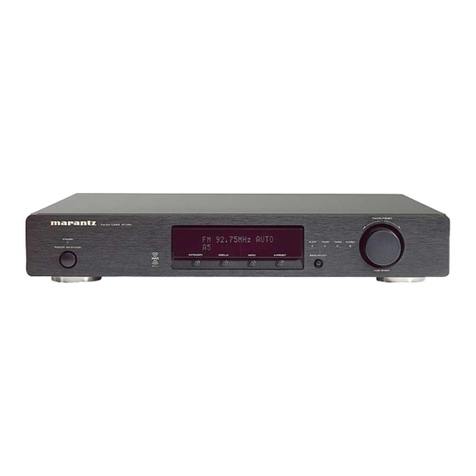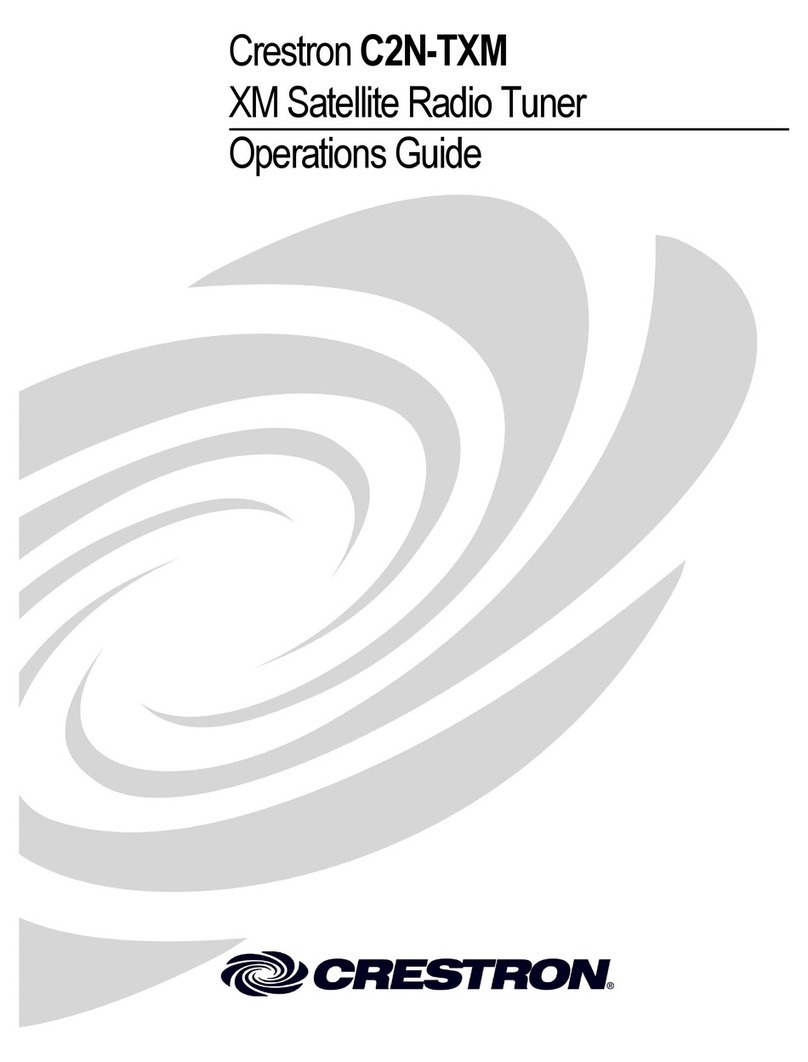5
ENGLISHFRANÇAIS
EQUIPMENT FRONT PANEL
CONNECTIONS AND CONTROLS
(Figure 2)
qPOWER SWITCH
Press to switch the power ON. Press again to switch to power OFF.
The mains switch is secondary connected and does not disconnect the
entire set from the mains.
wANTENNA BUTTON
This button is only operable when the FM band is selected.
This button selects FM ANTENNA A and FM ANTENNA B.
The selected side’s LED will light.
eIF BAND BUTTON
This button is only operable when the FM band is selected.
This button selects the IF band’s WIDE or NARROW setting.
The selected side’s LED will light.
WIDE: High quality audio can be listened to.
NARROW: Ability to select neighboring stations is improved.
rIR SENSOR
Receives the infrared remote control signal.
tMONO BUTTON
Press to switch the receiving mode between the auto stereo mode and
more mode.
When the button is pressed into the in position, the receiving mode
becomes the mono mode.
When the button is pressed again, the receiving mode becomes the
auto stereo mode.
yBAND BUTTON
Use this button to select FM or AM wave bands.
uMEMO BUTTON
Press to preset a receiving frequency in the memory. The MEMORY
indicator lights up for about 5 seconds when this button is pressed. It is
only during this period that a frequency can be preset in the memory.
iDISPLAY BUTTON
When this button is pressed while a station name is being displayed, the
display is switched to the frequency display.
Pressing the button again returns to the station name display; if no
station name has been stored for the station being received. “NO
NAME” is displayed when the button is pressed.
oST-NAME BUTTON
Press before manual input of station name.
For details, refer to “NANUAL INPUT OF STATION NAMES”.
!0 PRESET BUTTON
For switching the GYRO CONTROL ring to the preset mode.
!1 TUNING BUTTON
For switching the GYRO CONTROL ring to the tuning mode.
!2 AUTO BUTTON
For switching the GYRO CONTROL ring to the auto tuning mode.
!3 GYRO CONTROL RING
Used for dialing control of tuning up/down, preset up/down, station
name character display and PTY selection.
!4 DISPLAY
åMEMORY – This indicator lights up for about 5 seconds after the
MEMO button has been pressed.
∫PRESET – This indicator lights up when the PRESET button is
pressed.
çSTEREO – This indicator lights up when an FM stereo broadcast is
being received.
∂AUTO TUNING – This indicator lights up when the AUTO TUNING
mode.
éTUNING – This indicator lights up when the MANUAL TUNING
mode.
ƒTUNED – This indicator lights up when a station is tuned.
©FREQUENCY/STATION NAME – This indicator shows frequencies in
MHz (FM) or kHz (AM), (RDS) station name, radio text or names you
have assigned.
˙MONO – This indicator lights up in the MONO mode, which is
initiated when the MONO button is pressed.
OPERATION ON THE MAIN UNIT
SWITCHING ON AND OFF
When you want to switch you tuner on, press the POWER button.
When you wish to switch the unit off, simply press the POWER button
again.
SELECTING THE WAVE BAND
Select the desired wave band (FM, AM) by pressing the BAND
button. Pressing this button switches to the next wave band in the
following order: FM - AM - FM.
The display shows the selected band.
AUTO TUNING
This method can be used in areas where the signal strengths of the
broadcast atations are normal.
1. Confirm that the “AUTO” and “TUNING” indicators are lit on the
display. If not lit, turn the indicators on by pressing the TUNING
button and AUTO button.
2. Gently move the GYRO CONTROL ring.
The received frequency will automatically change and tuning will stop
when a station is received.
3. Repeat moving the GYRO CONTROL ring gently until the desired
station is received.
NOTE:
While the GYRO CONTROL ring is being turned, even if a station is
tuned in, it will not be stopped at.
MANUAL TUNING
This method can be used in areas where the signal strengths of the
broadcast atations are normal.
1. Confirm that the “TUNING” indicator is lit on the display. If not lit, turn
the indicator on by pressing the TUNING button.
2. If “AUTO” is lit on the display, press the AUTO button to turn it off.
3. Turn the GYRO CONTROL ring until the frequency you want is
received. The speed of received frequency display corresponds to
the speed that you turn the ring. Also, received frequencies will
change at 100kHz steps for FM and 9kHz steps for AM.
PRESET TUNING
Use the following procedure to recall a preset station directory from the
preset memory.
1. Ensure that the PRESET indicator is lit in the display. If nor, press the
PRESET button to light it..
2. Rotate the GYRO CONTROL ring to select the desired preset station.
PRESET MEMORY ON THE MAIN UNIT
This unit is equipped with the one-touch preset tuning system which is
particularly convenient when there is a large number of receivable
stations. The preset tuning system allows up to 60 stations on FM and
AM to be preset in a random order.
